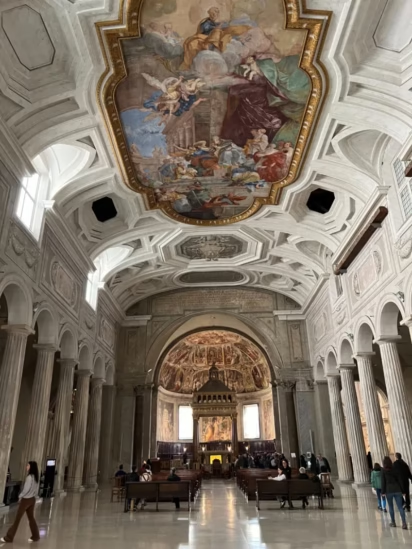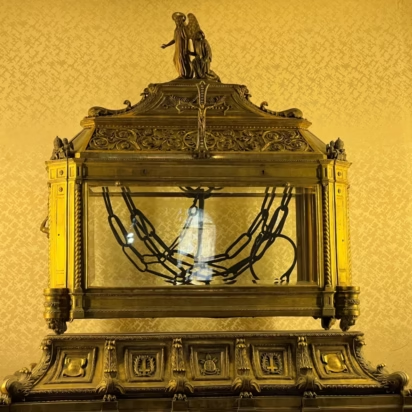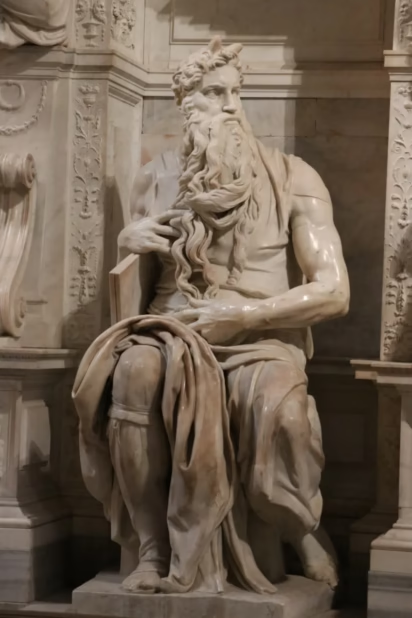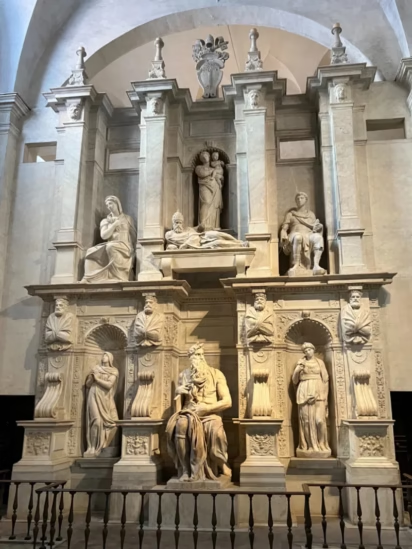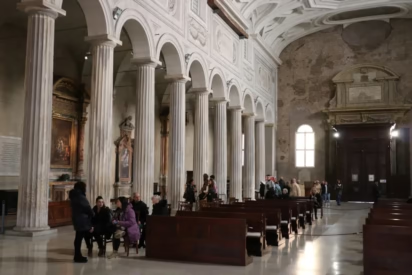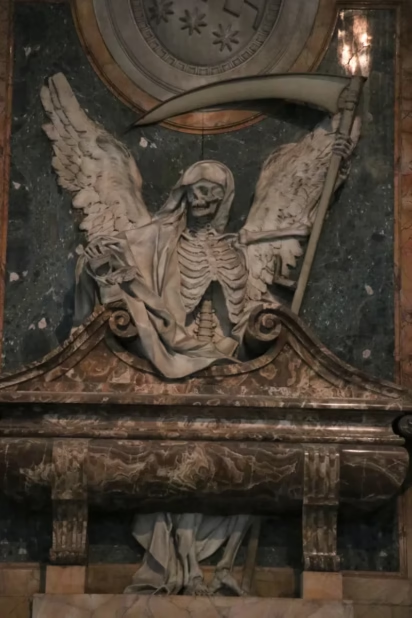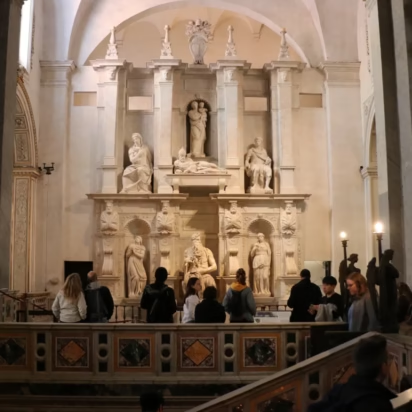The marble statue of Moses by Michelangelo and the chains of St Peter are the top reasons to visit the San Pietro in Vincoli minor basilica church near the Colosseum in Rome.

The Basilica Minor of San Pietro in Vincoli (Saint Peter in Chains) in Rome is an old church but is mostly visited to see Michelangelo’s Moses — a very large marble sculpture of a seated Moses, which is part of the Tomb of Pope Julius II. Religious pilgrims also visit to see the two sets of chains that the apostle Peter was shackled in — first in Jerusalem and ultimately in Rome. Further artworks in the church are interesting but not exceptional. However, for many seeing Moses by Michelangelo for free is already worth the short walk to the church from the Colosseum.
Basilica Minor of San Pietro in Vincoli (Saint Peter in Chains)
San Pietro in Vincoli (Saint Peter in Chains) is one of the oldest Christian churches in Rome. The first church here was completed around AD 400 but a second church was already erected in AD 440 to house the relics of St Peter’s chains.
The current church dates mostly from the Renaissance when major renovation work was carried out. The Renaissance influence is obvious from the moment visitors arrive at the church: the facade consists of a five-arches portico with wide flights of stairs leading up to a shady gallery rather than a typical church facade. The church is also without a bell tower.
The floor plan of a triple-nave basilica with nonprotruding transept and most of the main architectural elements of the church also date from the 16th century. The wide central nave is separated from the two narrow side aisles by 20 ancient Doric capitals that were already used in the church of AD440.
The coffered ceiling of the main nave is baroque but the exposed brickwork on the western wall clearly shows that the church has been altered several times with little attempt made to establish a harmoniously integrated decor. The crypt with the reliquary of St Peter’s chains, the double staircase, and the baldachin are from the late 19th century.
Few visit San Pietro in Vincoli for its architecture or decorations. For religious pilgrims, the relics of St Peter’s chains are the main attraction but most visitors come to admire Michelangelo’s Moses. As with most churches in Rome, the basilica has numerous further tombs, frescoes, paintings, and decorations that are interesting to see but none of these artworks are of particular interest so visitors tend to move on quickly after having seen Moses.
Moses by Michelangelo in St Peter in Chains
The marble Moses (Mosè di Michelangelo)in the St Peter in Chains church is after the Pieta in St Peter’s Basilica the most famous sculpture by Michelangelo in Rome.
This oversized sculpture of a seated Moses measures an impressive 235 cm × 210 cm (92.5 in × 82.6 in). Like Michelangelo’s David, the sculpture was originally designed to be placed much higher than the almost floor level where it was ultimately positioned.
Moses famously has the most luscious beard in Western sculpture art. He also has two small horns — these came from a mistranslation and are often seen in early Christian art. Although Michelangelo knew it should have been rays of light, two small horns were easier to sculpt.
Moses was admired already in Michelangelo’s lifetime and it remained very influential ever since. After seeing it, Goethe claimed he could never again envisage Moses in any other state than seated.
Tomb of Julius II in San Pietro in Vincoli
Moses was commissioned by Pope Julius II as part of his tomb, which should have been by far the largest tomb ever constructed for a pope in St Peter’s Basilica. The original tomb commission in 1505 included nearly 50 large sculptures — if completed, Moses would have sat at the corner on an upper level almost 4 m (over 12 ft) higher than he is seated now.
Michelangelo worked on sculptures for the planned tomb for over four decades. He was mostly busy elsewhere — including painting the Sistine Chapel — and following Julius’ death, the tomb was increasingly simplified.
Julius II died in 1513, around the time Michelangelo started working on Moses, and was interned in St Peter’s Basilica in the Vatican City — his grave is now just marked by an epitaph on a simple marble slab. His funerary monument in San Pietro in Vincoli, a church traditionally patronized by the Della Rovere family from which Julius II came, was completed in its far simpler form in 1545 by assistants of Michelangelo.
Michelangelo’s Sculptures on the Tomb of Julius II

The only sculpture Michelangelo completed on the final Tomb of Julius II is the seated Moses which became the center of the simplified work. He also worked on the two sculptures flanking Moses (but these were completed by assistants): Rachel and Leah, allegories of the contemplative and the active life — symbols of the two ways to salvation.
Michelangelo might have had a hand in the sculpture of Julius II but few agree on this. The other sculptures and details such as the family crest and candelabras are by other artists. These include a sybil and a prophet next to Julius II, as well as the Madonna and Child — a far cry from the 48-statue mausoleum Julius originally commissioned.
Other sculptures Michelangelo sculpted for the original tomb design include The Genius of Victory (now in the Palazzo Vecchio in Florence), the Dying and Rebellious Slaves (now in the Louvre, Paris), and the four unfinished slaves (prisoners) in the hall leading to David in the Accademia in Florence.
Chains of Peter in San Pietro in Vincoli in Rome

The chains of St Peter, on permanent display in a reliquary in the crypt, are the main religious attraction for pilgrims to San Pietro in Vincoli in Rome. According to tradition, this set of heavy chains is a combination of the chains the apostle was enchained with after his arrest in Jerusalem and the final chains he was shackled with in the Mamertine Prison in Rome prior to his execution.
In a famous scene in the Christian Bible (Acts 12, 6-11), Peter was freed by an angel from prison in Jerusalem after the chains fell off. These chains came into the possession of Empress Eudoxia who presented them to Pope Leo I. When Leo I compared them to the chains from the Mamertine Prison, the two sets fused into one and were never separated again.
More Art in St Peter in Chains in Rome
San Pietro in Vincoli certainly is not the art tour de force of so many other churches in Rome but in addition to Moses, which alone makes the church worth visiting, a few further interesting artworks include:
The frescos by Giacomo Coppi (1577) in the raised tribune illustrate the liberation of Peter from the chains in Jerusalem, Eodixia receiving the chains, and Eodixia presenting them to Pope Leo.
The main ceiling fresco in the nave of the church is The Miracle of the Chains by Giovanni Battista Parodi (1706). It shows Pope John XII using the chains to exorcise a demon from the court of German Emperor Otto I.
The mosaic of St. Sebastian dates from the 7th century. It is more in the artistic style of the Eastern tradition — St. Sebastian is a bearded man and not a nude young male being pierced by arrows as became popular in later centuries. (It also reminds, perhaps unintentionally, that one of the wonders was that St. Sebastian survived the arrows, although he was clobbered to death at age 32, long before he could be presented as a bearded old man.)
Although the Tomb of Julius II is the most famous work in the church, it has several further interesting tombstones:
- Cardinal Mariano Vecchiarelli (1639) — decorated with two full skeletons in a danse macabre reminding of the fleetingness of human life on earth.
- Cardinal Cinzio Aldobrandini (1707) by Bizzaccheri and Le Gros — the grim reaper as death in the form of a winged skeleton holding a scythe and hourglass.
- Cardinal Cusa (Nicolaus Krebs from Trier, 1464) — a Renaissance relief by Andrea Bregno.
Painter and sculptor Antonio del Pollaiuolo (and his brother Piero) is buried at the left side of the entrance. He was the Florentine sculptor who added the figures of Romulus and Remus to the sculpture of the Capitoline She-Wolf (the original is now in the Capitoline Museum). Above their busts is a plague fresco by an unknown artist, around 1500.
How to See Moses by Michelangelo in St Peter in Chains

San Pietro in Vincoli Opening Hours
The Basilica Minor of San Pietro in Vincoli (St Peter in Chains) is open for tourist visits daily from 8:00 to noon and 15:00 to 18:00 (19:00 in summer). On some religious holidays, it only opens at 9:00. Closure for services is less likely in the afternoon.
It is often very busy right after reopening at 15:00 but most visitors move along quickly after seeing Moses.
Admission to the church is free but coins may be needed to light up Moses and coins may also activate the organ.
San Pietro in Vincoli has no functional website but the information boards in the church are in both English and Italian.
The cloisters are part of the university but may be visited for free too — use the door to the right at the top of the stairs outside the church.
Transportation to St Peter in Chains
Getting to San Pietro in Vincoli in Rome is easy. It is a short walk from the Colosseum (Metro A) although approaching from Cavour (Metro B) is marginally quicker — use the steps Salita dei Borgia or San Fresco di Paolo from Via Cavour. Signposting to S. Pietro in Vincoli is fairly clear.
